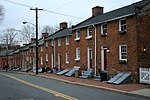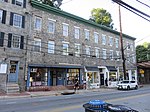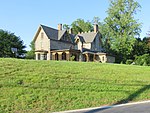Trolley Line Number 9 Trail
Bike paths in MarylandCatonsville, MarylandEllicott City, MarylandHiking trails in MarylandOella, Maryland ... and 4 more
Protected areas of Baltimore County, MarylandProtected areas of Howard County, MarylandRail trails in MarylandTransportation in Baltimore County, Maryland
The Historical Ellicott City/Baltimore Trolley Line #9 Trail is a 1.25-mile (2.0 km) trail in western Baltimore County, Maryland. It begins at the west end of Edmondson Avenue and extends from Catonsville through Oella to Main Street, Ellicott City. The trail follows what was originally part of the Catonsville and Ellicott City Electric Railway Company trolley line that shuttled passengers between Ellicott City and Baltimore from the late 1890s to the mid-1950s.
Excerpt from the Wikipedia article Trolley Line Number 9 Trail (License: CC BY-SA 3.0, Authors).Trolley Line Number 9 Trail
Trolley Line #9 Trail,
Geographical coordinates (GPS) Address External links Nearby Places Show on map
Geographical coordinates (GPS)
| Latitude | Longitude |
|---|---|
| N 39.270597222222 ° | E -76.779763888889 ° |
Address
Trolley Line #9 Trail
Trolley Line #9 Trail
21052
Maryland, United States
Open on Google Maps








